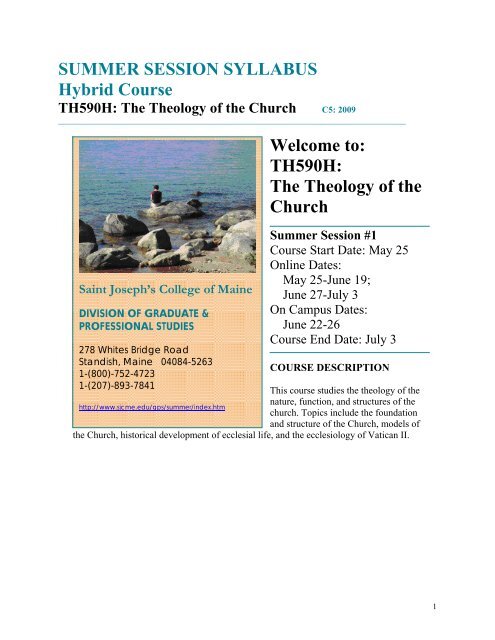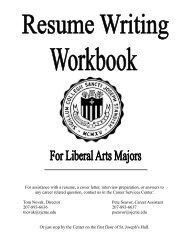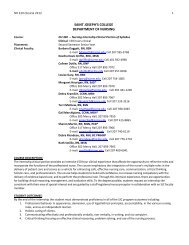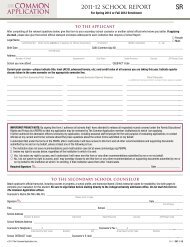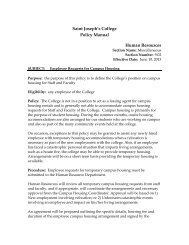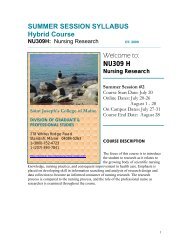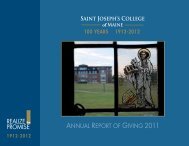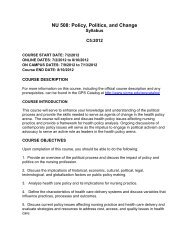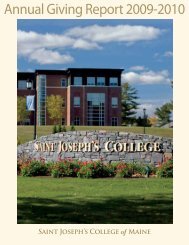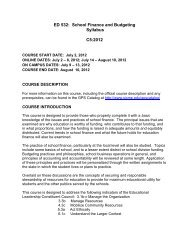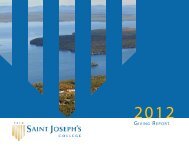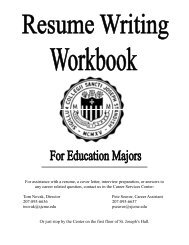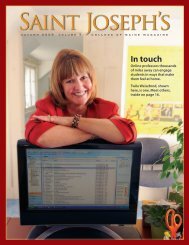TH590H: The Theology of the Church - Saint Joseph's College ...
TH590H: The Theology of the Church - Saint Joseph's College ...
TH590H: The Theology of the Church - Saint Joseph's College ...
You also want an ePaper? Increase the reach of your titles
YUMPU automatically turns print PDFs into web optimized ePapers that Google loves.
SUMMER SESSION SYLLABUS<br />
Hybrid Course<br />
<strong>TH590H</strong>: <strong>The</strong> <strong>The</strong>ology <strong>of</strong> <strong>the</strong> <strong>Church</strong> C5: 2009<br />
______________________________________________________________________________________<br />
<strong>Saint</strong> Joseph’s <strong>College</strong> <strong>of</strong> Maine<br />
DIVISION OF GRADUATE &<br />
PROFESSIONAL STUDIES<br />
278 Whites Bridge Road<br />
Standish, Maine 04084-5263<br />
1-(800)-752-4723<br />
1-(207)-893-7841<br />
Welcome to:<br />
<strong>TH590H</strong>:<br />
<strong>The</strong> <strong>The</strong>ology <strong>of</strong> <strong>the</strong><br />
<strong>Church</strong><br />
Summer Session #1<br />
Course Start Date: May 25<br />
Online Dates:<br />
May 25-June 19;<br />
June 27-July 3<br />
On Campus Dates:<br />
June 22-26<br />
Course End Date: July 3<br />
COURSE DESCRIPTION<br />
This course studies <strong>the</strong> <strong>the</strong>ology <strong>of</strong> <strong>the</strong><br />
nature, function, and structures <strong>of</strong> <strong>the</strong><br />
http://www.sjcme.edu/gps/summer/index.htm<br />
church. Topics include <strong>the</strong> foundation<br />
and structure <strong>of</strong> <strong>the</strong> <strong>Church</strong>, models <strong>of</strong><br />
<strong>the</strong> <strong>Church</strong>, historical development <strong>of</strong> ecclesial life, and <strong>the</strong> ecclesiology <strong>of</strong> Vatican II.<br />
1
IMPORTANT RESOURCES<br />
If you have any questions regarding your course materials, please contact your<br />
academic advisor (1-800-343-5498) and/or our book vendor EdMap. You can<br />
reach EdMap by phone or email:<br />
1-(800)-274-9104<br />
http://www.shop-edmap.biz/sjs/<br />
All <strong>Saint</strong> Joseph’s <strong>College</strong> students must have a library card for <strong>the</strong> Wellehan<br />
Library prior to arriving on campus. To obtain your card, if you do not already<br />
have one, please call <strong>the</strong> library or visit <strong>the</strong>ir Website:<br />
1-(800) 343-5498 ext. 7725<br />
http://www.sjcme.edu/library/index.htm<br />
REQUIRED TEXT<br />
Catechism <strong>of</strong> <strong>the</strong> Catholic <strong>Church</strong>. United States Catholic Conference, Second Edition,<br />
2003. ISBN 0-385-50819-0<br />
Flannery, Austin, ed., Vatican Council II: Vol. 1 <strong>The</strong> Conciliar and Post Conciliar<br />
Documents, New Revised Edition. Costello, 1998. ISBN 0-918344-39-5<br />
Hahnenberg, Edward. A Concise Guide to <strong>the</strong> Documents <strong>of</strong> Vatican II. St. Anthony<br />
Messenger Press, 2007. ISBN-10 086765529<br />
Phan, Peter (ed.). <strong>The</strong> Gift <strong>of</strong> <strong>the</strong> <strong>Church</strong>: A Textbook on Ecclesiology in Honor <strong>of</strong><br />
Patrick Granfield, O.S.B. <strong>College</strong>ville: Liturgical Press, 2000. ISBN 0814659314<br />
REQUIRED ARTICLES<br />
Pope John Paul 11. “Ut Unam Sint.” June, 1995. (This can be downloaded).<br />
E-reserves:<br />
Brown, Osiek & Perkins, “<strong>Church</strong> in <strong>the</strong> New Testament.” pp. 782-784 (New Jerome<br />
Biblical Commentary)<br />
Brown, Osiek & Perkins, “<strong>The</strong> Kingdom <strong>of</strong> God.”pp. 1339-1346 (New Jerome Biblical<br />
Commentary)<br />
Hubesch, Bill, Vol. 1 <strong>The</strong> Council p. 101-106<br />
2
Huebsch, Bill. Vatican II In Plain English, Vol. 1, Biographies, pp. 173-191.<br />
Lawler, Michael and Thomas Shanahan. <strong>Church</strong>: A Spirited Communion, Chapter 4, pp.<br />
54-69.<br />
Murphy, Charles. “Charity, Not Justice, Consituitive <strong>of</strong> <strong>the</strong> Gospel,” in <strong>The</strong>ological<br />
Studies, June, 2007. (see E-reserve)<br />
Rausch, Thomas, Towards a Truly Catholic <strong>Church</strong>. Chapter 7, “<strong>The</strong> Marks <strong>of</strong> <strong>the</strong><br />
<strong>Church</strong>,” pp. 131-151.<br />
Password for E-reserves TH590Jan08<br />
WRITTEN ASSIGNMENTS (All should be brought to campus and submitted on <strong>the</strong><br />
day <strong>the</strong> topic is covered)<br />
Unit One:<br />
Write a 2 to 3-page double-spaced paper reflecting on your insights from <strong>the</strong> reading<br />
and activity for this lesson. Be sure to include at least one-half page on both a, b, and<br />
one page on c:<br />
Unit Two<br />
a. Any images <strong>of</strong> <strong>Church</strong> that have persisted through <strong>the</strong> years and how <strong>the</strong>y<br />
affect your current <strong>the</strong>ology <strong>of</strong> <strong>Church</strong><br />
b. Any images <strong>of</strong> <strong>Church</strong> that have dropped away or been added and how <strong>the</strong>y<br />
affect your current <strong>the</strong>ology <strong>of</strong> <strong>Church</strong><br />
c. How your understanding <strong>of</strong> <strong>the</strong> <strong>the</strong>ology <strong>of</strong> <strong>the</strong> <strong>Church</strong> corresponds to what<br />
<strong>the</strong> <strong>Church</strong> teaches about itself, as found in this first unit<br />
Write a five page, double-spaced paper including <strong>the</strong> following:<br />
• <strong>The</strong> purpose <strong>of</strong> both <strong>the</strong> Protestant Reformation and <strong>the</strong> Catholic Reformation and<br />
<strong>the</strong> affect each had on <strong>the</strong> <strong>the</strong>ology <strong>of</strong> <strong>the</strong> <strong>Church</strong><br />
• <strong>The</strong> role played by Martin Lu<strong>the</strong>r and St. Ignatius <strong>of</strong> Loyola in <strong>the</strong> Protestant<br />
Reformation and <strong>the</strong> Catholic Counter-Reformation and <strong>the</strong> contributions each<br />
made to Roman Catholic ecclesiology<br />
• <strong>The</strong> Lu<strong>the</strong>ran and Catholic positions on justification<br />
Create an Annotated Outline <strong>of</strong> <strong>the</strong> primary influences affecting <strong>the</strong> <strong>the</strong>ology <strong>of</strong> <strong>the</strong><br />
<strong>Church</strong> between Vatican I and Vatican II<br />
3
Unit Three<br />
1. Write a five-page double-spaced paper on <strong>the</strong> Contribution <strong>of</strong> Popes to <strong>the</strong><br />
<strong>The</strong>ology <strong>of</strong> <strong>the</strong> <strong>Church</strong>, being sure to include no less than 5 significant Popes<br />
whose pontificates added to our current understanding and exercise <strong>of</strong> <strong>the</strong> Papacy;<br />
identify <strong>the</strong>ir contribution and indicate its significance in <strong>the</strong> <strong>the</strong>ology <strong>of</strong> <strong>the</strong><br />
<strong>Church</strong>.<br />
2. Evaluate <strong>the</strong> unique contributions to <strong>the</strong> ecumenical age and <strong>the</strong><br />
importance to Catholics <strong>of</strong> one <strong>of</strong> <strong>the</strong> Popes<br />
3. Develop a PowerPoint presentation which could be shown to an adult education<br />
class, comparing and contrasting how each <strong>of</strong> <strong>the</strong> Popes’ mentioned above<br />
exercise (d) <strong>the</strong>ir Petrine Ministry for <strong>the</strong> good <strong>of</strong> <strong>the</strong> <strong>Church</strong>.<br />
a. Include with <strong>the</strong> PowerPoint, a script explaining your slides as a separate<br />
document.<br />
Unit Four<br />
1. Create and submit an annotated list <strong>of</strong> five significant <strong>the</strong>ological contributions<br />
that <strong>the</strong> document, Lumen Gentium, <strong>of</strong>fers your understanding <strong>of</strong> <strong>the</strong> <strong>the</strong>ology <strong>of</strong><br />
<strong>the</strong> <strong>Church</strong>. [An annotated list means that you will <strong>of</strong>fer a paragraph or two on<br />
each item listed, explaining its significance].<br />
2. Write a three to five-page, double-spaced paper describing:<br />
• <strong>the</strong> vision <strong>of</strong> <strong>the</strong> <strong>Church</strong> proclaimed by Lumen Gentium, and<br />
• what this vision inspires in you as a disciple <strong>of</strong> Christ.<br />
Unit Five<br />
Write a three page double spaced paper indicating why <strong>the</strong> dignity <strong>of</strong> <strong>the</strong> human<br />
person is <strong>the</strong> key to all Catholic social teaching including some practical ways in<br />
which <strong>the</strong> Catholic <strong>Church</strong> is upholding <strong>the</strong> dignity <strong>of</strong> <strong>the</strong> human person in <strong>the</strong> world<br />
today” Be sure to include how this principle is addressed in GS in at least 1 page <strong>of</strong><br />
<strong>the</strong> paper.<br />
4
Your Instructor<br />
______________________________________________________________________________________<br />
.<br />
Hi and Welcome to TH590: <strong>The</strong> <strong>The</strong>ology <strong>of</strong> <strong>the</strong><br />
<strong>Church</strong>.<br />
Name: Linda Perrone Rooney<br />
Email: lrooney@sjcme.edu<br />
Phone: (863) 324-7126<br />
I am President <strong>of</strong> Rooney Consultants, based in<br />
Winter Haven, Florida. Rooney Consultants strives to<br />
make <strong>the</strong> world a better place one person at a time by<br />
<strong>of</strong>fering pr<strong>of</strong>essional, organizational, pastoral, and<br />
<strong>the</strong>ological services to faith-based organizations,<br />
educational and health-care institutions, non-pr<strong>of</strong>it<br />
organizations and individuals. I’ve assisted numerous<br />
dioceses, parishes, national associations, boards, health<br />
care institutions, groups and individuals to reach <strong>the</strong>ir<br />
goals and improve <strong>the</strong> quality <strong>of</strong> <strong>the</strong>ir lives and work.<br />
I first joined <strong>the</strong> faculty <strong>of</strong> <strong>Saint</strong> Joseph <strong>College</strong> in<br />
2001, after serving on graduate faculties in o<strong>the</strong>r<br />
Catholic Universities over <strong>the</strong> years. At SJC, I’ve<br />
taught both distance and on-campus courses in<br />
Ecclesiology, Christology, <strong>The</strong>ology <strong>of</strong> Ministry,<br />
<strong>The</strong>ological Reflection, Spiritual Direction and <strong>Church</strong> Leadership and Management and<br />
Ministry to <strong>the</strong> Aging, Sick and Dying. I’ve also supervised graduate projects. I received my<br />
Doctor <strong>of</strong> Ministry Degree from Pittsburgh <strong>The</strong>ological Seminary and am certified in over ten<br />
areas <strong>of</strong> ministry and administration specialties.<br />
I served as Director <strong>of</strong> Lay Ministry Development for <strong>the</strong> Diocese <strong>of</strong> Orlando for 25 years, and<br />
have held positions as Elementary teacher, Principal <strong>of</strong> a High School, Manager <strong>of</strong> Migrant Child<br />
Care Project, Director <strong>of</strong> Religious Education in several parishes, Board Chair <strong>of</strong> <strong>the</strong> National<br />
Association for Lay Ministry (NALM), Regional Director and Leadership Council member <strong>of</strong> <strong>the</strong><br />
National Association <strong>of</strong> Catholic Chaplains (NACC), Director <strong>of</strong> a large, multicultural lay<br />
ministry department, Catholic chaplain and CPE supervisor, grant writer, teacher in Community<br />
<strong>College</strong> nursing programs and most recently, founder and director <strong>of</strong> my own consulting firm.<br />
In addition to this work experience, I am a practicing spiritual director, teach in adult education<br />
courses and <strong>of</strong>fer coaching services. I’ve written and published two video-based training<br />
programs and numerous articles, including an everyday spirituality column for a local newspaper.<br />
I’ve had four books published with one due 2009.<br />
<strong>The</strong> first part <strong>of</strong> my life was lived in a pre-Vatican II <strong>Church</strong> and I retain a love for <strong>the</strong> <strong>Church</strong>’s<br />
traditions and historical contributions to my faith. My young adulthood to <strong>the</strong> present was<br />
formed by <strong>the</strong> Second Vatican Council and it is it’s <strong>the</strong>ology that most shapes my understanding<br />
<strong>of</strong> who God is and how God works in and through Jesus Christ to communicate <strong>the</strong> good news <strong>of</strong><br />
God’s love. This is a foundational course in <strong>the</strong> preparation <strong>of</strong> a pastoral leader. I look forward<br />
to sharing it with you.<br />
5
Student Resources<br />
_________________________________________________________________________________<br />
COURSE POLICIES AND PROCEDURES<br />
Current information regarding <strong>College</strong> policies affecting your course can be found on <strong>the</strong><br />
Resources/Policy section <strong>of</strong> <strong>the</strong> ANGEL course homepage.<br />
On this page, you will find vital information, including <strong>the</strong> following:<br />
• Current Student Handbook, outlining course-specific policies<br />
o Includes grading rubric<br />
• Access to support resources, including advising and online tutorial services<br />
• Student Success Guides<br />
SUBMITTING ASSIGNMENTS<br />
Instructions on how to submit your assignment to your instructor can be found on your<br />
ANGEL course site.<br />
6
Course Overview<br />
______________________________________________________________________________________<br />
COURSE INTRODUCTION<br />
TH590: <strong>The</strong> <strong>The</strong>ology <strong>of</strong> <strong>the</strong> <strong>Church</strong> is a<br />
study <strong>of</strong> <strong>the</strong> nature, origins and mission <strong>of</strong><br />
<strong>the</strong> <strong>Church</strong> as understood by <strong>the</strong> Roman<br />
Catholic <strong>Church</strong>. <strong>The</strong> five units that<br />
comprise <strong>the</strong> course each cover a specific<br />
element <strong>of</strong> learning essential to this study.<br />
Unit 1 defines what it means to be church<br />
and invites you to understand <strong>the</strong> nature <strong>of</strong><br />
systematic <strong>the</strong>ology and <strong>the</strong> place <strong>of</strong><br />
ecclesiology (<strong>the</strong> <strong>the</strong>ology <strong>of</strong> <strong>the</strong> church)<br />
within that field. It distinguishes <strong>the</strong><br />
various types <strong>of</strong> <strong>the</strong>ology and notes that <strong>the</strong> study you are undertaking is within <strong>the</strong> subfield<br />
<strong>of</strong> pastoral <strong>the</strong>ology. Unit two reviews <strong>the</strong> historical development <strong>of</strong> <strong>the</strong> church and<br />
highlights <strong>the</strong> contributions and challenges <strong>of</strong> each age. It is in studying its history that<br />
you come to see how <strong>the</strong> twenty-first century church has evolved to what it is today. Unit<br />
three draws your attention to <strong>the</strong> papacy, in particular to <strong>the</strong> development <strong>of</strong> <strong>the</strong> doctrines<br />
known as papal primacy and <strong>the</strong> petrine ministry, and gives an overview <strong>of</strong> how four<br />
contemporary popes lived <strong>the</strong>ir role. This unit also ponders <strong>the</strong> question <strong>of</strong> <strong>the</strong> role <strong>of</strong> <strong>the</strong><br />
papacy in achieving Christian unity. Units four and five look at <strong>the</strong> understanding <strong>of</strong><br />
<strong>Church</strong> promulgated by <strong>the</strong> Second Vatican Council, specifically its two pillars, Lumen<br />
Gentium and Gaudiam et Spes. In <strong>the</strong>se documents you find <strong>the</strong> heart <strong>of</strong> <strong>the</strong> <strong>Church</strong>’s<br />
internal self-understanding and external mission. Fur<strong>the</strong>r in Unit 5, you will explore an<br />
understanding <strong>of</strong> ministry that flows from <strong>the</strong> previous work and which leads to <strong>the</strong><br />
concluding lesson on contemporary pastoral challenges.<br />
<strong>The</strong> <strong>the</strong>ology <strong>of</strong> <strong>the</strong> <strong>Church</strong> is an interactive course. It challenges you to enter<br />
into your study from several vantage points: through discussion with your peers on <strong>the</strong><br />
ANGEL discussion board, through activities like developing charts and power-point<br />
presentations, researching through optional readings and through writing papers that<br />
syn<strong>the</strong>size and demonstrate your grasp and integration <strong>of</strong> <strong>the</strong> study material. At all times,<br />
a primary goal <strong>of</strong> <strong>the</strong> course is to help you to apply your learning to your own faith<br />
development and to <strong>the</strong> pastoral life <strong>of</strong> <strong>the</strong> church, for this degree, Master in Pastoral<br />
<strong>The</strong>ology, is based on <strong>the</strong> premise that completion <strong>of</strong> this program will equip you for<br />
pastoral ministry.<br />
7
COURSE OBJECTIVES<br />
Upon completion <strong>of</strong> this course, you should be able to do <strong>the</strong> following:<br />
• Understand <strong>The</strong> <strong>The</strong>ology <strong>of</strong> <strong>the</strong> <strong>Church</strong> as a field within systematic <strong>the</strong>ology and<br />
how it relates to <strong>the</strong> rest <strong>of</strong> <strong>the</strong> MAPT curriculum<br />
• Appreciate <strong>the</strong> <strong>the</strong>ological and historical contexts for <strong>the</strong> <strong>Church</strong>’s ever-evolving<br />
self-understanding and mission<br />
• Understand and discuss <strong>the</strong> role <strong>of</strong> papal primacy in <strong>the</strong> <strong>the</strong>ology <strong>of</strong> <strong>the</strong> <strong>Church</strong><br />
and its place in <strong>the</strong> efforts toward Christian Unity<br />
• Demonstrate a comprehensive grasp <strong>of</strong> <strong>the</strong> Second Vatican Council’s teaching,<br />
especially as found in its documents, recognizing it as a seminal ecclesial event<br />
and as a source for a revitalized vision <strong>of</strong> <strong>the</strong> church in <strong>the</strong> third millennium<br />
• Name and summarize <strong>the</strong> 16 documents <strong>of</strong> <strong>the</strong> Second Vatican Council with<br />
appropriate grasp <strong>of</strong> <strong>the</strong>ir authoritative distinctions<br />
• Interpret and apply <strong>the</strong> teachings <strong>of</strong> <strong>the</strong> Second Vatican Council to 21 st century<br />
pastoral challenges<br />
8
COURSE FORMAT<br />
This is an accelerated six week online course: 4 weeks online, one week campus<br />
residency and a final week online. <strong>The</strong> five units in TH 590 are developed in a reflective<br />
manner: What is <strong>the</strong> <strong>The</strong>ology <strong>of</strong> <strong>the</strong> <strong>Church</strong>; <strong>The</strong> <strong>Church</strong> Jesus Founded; An Historical<br />
Overview <strong>of</strong> Papal Primacy; <strong>The</strong> <strong>Church</strong> <strong>of</strong> Vatican II; <strong>The</strong> <strong>Church</strong> in <strong>the</strong> Third<br />
Millennium. <strong>The</strong> course uses <strong>the</strong> following components to engage <strong>the</strong>se topics, measure<br />
your understanding <strong>of</strong> <strong>the</strong> course content, and assess your ability to apply what you have<br />
learned to actual situations:<br />
• Reading and journal keeping are an essential part <strong>of</strong> <strong>the</strong> course. In addition to <strong>the</strong><br />
assigned reading and optional suggestions, materials will be listed on E-Reserves<br />
and various website links will be <strong>of</strong>fered for consideration.<br />
• Assessment instruments and self-tests to help you assess your personal place within<br />
a specific content <strong>of</strong> learning and <strong>the</strong>n apply that information to <strong>the</strong> learning<br />
objectives<br />
• Written assignments where each unit will require one or more written assignments<br />
and related activities.<br />
• Discussion Board participation with instructor and classmates. A full description <strong>of</strong><br />
this involvement can be found in <strong>the</strong> syllabus.<br />
• A research paper is required after finishing Unit 5. <strong>The</strong> material for <strong>the</strong> research<br />
project will be accumulated and outlined during <strong>the</strong> course itself and <strong>the</strong>n completed<br />
in <strong>the</strong> final two online weeks <strong>of</strong> study.<br />
• O<strong>the</strong>r learning tools will be employed as needed to enhance <strong>the</strong> course.<br />
In summary:<br />
May 25-June 19; June 27-July 3, 2009<br />
June 22-26, 2009<br />
June 27-July 3<br />
Online<br />
Campus Residency<br />
Online Post-residency<br />
COURSE GUIDELINES<br />
• To do your best in TH590 it is wise to do all <strong>the</strong> readings, don’t skip any.<br />
• Take notes as you read, indicating questions you want to ask or fur<strong>the</strong>r research<br />
you want to do.<br />
• Be diligent in keeping track <strong>of</strong> quotes and reference sources so that when you<br />
write, you are able to give accurate citations, in MLA format.<br />
• You would do well to read through all <strong>the</strong> unit objectives, activities and writing<br />
before starting in order to get a sense <strong>of</strong> how <strong>the</strong> course is developed and what<br />
9
.<br />
you will be covering, so that as you read or see helpful materials, etc., you can<br />
collect or note <strong>the</strong>m for use down <strong>the</strong> line.<br />
• Since this is a Masters course, it is expected that you will produce graduate level<br />
work, demonstrating your “mastery” <strong>of</strong> <strong>the</strong> material, use <strong>of</strong> required and research<br />
sources, scholarly writing and original thinking , with attention to <strong>the</strong> basics <strong>of</strong><br />
grammar and spelling, etc.<br />
• You are welcome to ask questions <strong>of</strong> your instructor at any time, and/or, to seek<br />
advice or clarification as needed.<br />
• Keep in mind that only one unit may be sent at a time, with no unit sent until <strong>the</strong><br />
previous unit/grade is received. Some students find it helpful to create a chart that<br />
divides <strong>the</strong>ir units into <strong>the</strong> number <strong>of</strong> weeks for <strong>the</strong> entire course and <strong>the</strong>n create a<br />
timeline for completion <strong>of</strong> each unit. Units are generally returned within one-three<br />
days after reception, <strong>the</strong>re may be times when it takes longer.<br />
• Adhering to <strong>the</strong> suggestions above and good time management should help you to<br />
succeed in completing <strong>the</strong> course in a superior way.<br />
Your course guidelines …<br />
EVALUATION<br />
• Class Participation ...............................................................................................40%<br />
• Written Assignments ............................................................................................ 40%<br />
• Final Project ......................................................................................................... 20%<br />
PLEASE NOTE: If life gets in <strong>the</strong> way <strong>of</strong> your online classroom responsibilities, you<br />
must notify your instructor as soon as you aware that events may occur that may inhibit<br />
you from participating at <strong>the</strong> required level.<br />
10
Class Schedule<br />
________________________________________________________________________<br />
PERIOD TOPIC ASSIGNMENT<br />
Online Week 1<br />
May 25-28<br />
Obj.-<br />
To grasp vocabulary<br />
and basic concepts <strong>of</strong><br />
<strong>the</strong>ology <strong>of</strong> <strong>the</strong> <strong>Church</strong><br />
What is <strong>the</strong> <strong>The</strong>ology <strong>of</strong> <strong>the</strong><br />
<strong>Church</strong> and Why Study it<br />
• Why Study <strong>the</strong><br />
<strong>The</strong>ology <strong>of</strong> <strong>the</strong><br />
<strong>Church</strong><br />
• What Does It Mean to<br />
be <strong>Church</strong><br />
Readings:<br />
• Phan Text Chapter 7, pp. 129ff<br />
• Study Notes—Unit 1, Lesson 1.1 ;<br />
Lesson 1.2<br />
• E-reserve: Thomas Rausch, Towards a<br />
Truly Catholic <strong>Church</strong>. Chapter 7, “<strong>The</strong><br />
Marks <strong>of</strong> <strong>the</strong> <strong>Church</strong>,” pp. 131-151.<br />
• Catechism <strong>of</strong> <strong>the</strong> Catholic <strong>Church</strong> Text,<br />
197-230; 781-865<br />
• Website: Glossary <strong>of</strong> terms related to<br />
ecclesiology (see activities, below)<br />
http://catholic-resources.org<br />
http://catholic-resources.org/Bible/NT-<br />
<strong>The</strong>ology-Ecclesiology.htm<br />
Self-test (see ANGEL)<br />
After accessing and downloading or reading<br />
<strong>the</strong> glossary provided on <strong>the</strong> website<br />
http://catholic-<br />
resources.org/Bible/NT-<strong>The</strong>ology-<br />
Ecclesiology.htm, as well as your o<strong>the</strong>r<br />
readings:<br />
• Take <strong>the</strong> “Terms in Ecclesiology” selftest<br />
• Send an email to your instructor<br />
informing her <strong>of</strong> how you did on your<br />
self-test and explain what learning <strong>the</strong><br />
vocabulary words does to add to your<br />
ability to study <strong>the</strong> <strong>the</strong>ology <strong>of</strong> <strong>the</strong><br />
<strong>Church</strong>.<br />
Activity<br />
• Refer to <strong>the</strong> diagram (Unit 1, Lesson 1.2<br />
Continuum Diagram) on <strong>the</strong> WebCT<br />
11
page for this course.<br />
• Use this diagram and timeline ei<strong>the</strong>r to<br />
stimulate your thinking or as <strong>the</strong> actual<br />
format (downloaded and expanded as<br />
necessary) for <strong>the</strong> following:<br />
o<br />
Within each era, list <strong>the</strong> images<br />
(models) <strong>of</strong> <strong>Church</strong> that seemed to<br />
dominate your understanding <strong>of</strong><br />
<strong>Church</strong> during that timeframe.<br />
[<strong>The</strong>se do not need to correspond<br />
to any texts, <strong>the</strong>y are your images]<br />
• Reflect on this exercise. What do you<br />
see Have changes occurred Which<br />
images remain constant How has <strong>the</strong><br />
retention or change in your images <strong>of</strong><br />
church affected your faith journey and<br />
your appreciation <strong>of</strong> <strong>the</strong> church and selfunderstanding<br />
Discussion posting: Why does <strong>the</strong> <strong>Church</strong> use<br />
images and models to explain its <strong>the</strong>ology Is<br />
this method a help or a hindrance to your grasp<br />
<strong>of</strong> <strong>the</strong>ology What do you most want to learn<br />
from this course<br />
Online week 2<br />
May 29-June 9 th<br />
Obj. To review <strong>the</strong><br />
history <strong>of</strong> <strong>the</strong> <strong>the</strong>ology<br />
<strong>of</strong> <strong>the</strong> <strong>Church</strong> and<br />
understand its<br />
implications for<br />
ongoing <strong>the</strong>ological<br />
development<br />
<strong>The</strong> <strong>Church</strong> Jesus Founded:<br />
Unchanged and Changing<br />
• <strong>The</strong>ologies <strong>of</strong> <strong>Church</strong> in<br />
<strong>the</strong> New Testament,<br />
Patristics, Reformation,<br />
Modernity to 20 th<br />
Century<br />
Read this first:<br />
<br />
http://dlibrary.acu.edu.au/research/<strong>the</strong>olog<br />
y/Kannengiesser.htm Article by Charles<br />
Kannengiesser, “<strong>The</strong> Relevance <strong>of</strong><br />
Exploring Christian Origins.”<br />
Phan Text Chapter 1, pp. 3-21;<br />
Chapter 2, pp. 23-40<br />
Lumen Gentium Chapter 1<br />
Brown, Osiek & Perkins Text, “<strong>Church</strong> in<br />
<strong>the</strong> New Testament. pp. 782-784<br />
Brown, Osiek & Perkins Text, “<strong>The</strong><br />
Kingdom <strong>of</strong> God.” pp. 1339-1346<br />
12
Schneiders, Sandra, “<strong>Church</strong> and Biblical<br />
Scholarship in Dialogue,” <strong>The</strong>ology<br />
Today: October, 1985.<br />
.<br />
<strong>The</strong> following websites will help you to<br />
discover <strong>the</strong> History <strong>of</strong> <strong>the</strong> <strong>Church</strong>:<br />
http://www.ourcatholicfaith.org/churchhistory.<br />
html (brief and chronological)<br />
http://www.britannica.com/eb/article-<br />
9109699/history-<strong>of</strong>-Roman-Catholicism (more<br />
involved...120 pages).<br />
http://bible.christiansunite.com/schindex.shtml<br />
(by time period)<br />
http://shclibrary.shc.edu/ (SpringHill<br />
college library source)<br />
ACTIVITIES<br />
1. As you read <strong>The</strong> Gift, and <strong>the</strong> first<br />
chapter <strong>of</strong> Lumen Gentium:<br />
• Create a list <strong>of</strong> biblical<br />
images/metaphors you find <strong>the</strong>re<br />
• Choose one image/metaphor (e.g.,<br />
sheepfold) or cluster <strong>of</strong> related<br />
metaphors (plant, vine, gardening)<br />
that best describes your experience<br />
<strong>of</strong> church and send an email to<br />
your instructor explaining your<br />
choice and how it affects your<br />
“lived” understanding <strong>of</strong> church.<br />
2. Create a four-column “Summary” <strong>of</strong><br />
<strong>the</strong> primary heresies <strong>of</strong> each <strong>of</strong> <strong>the</strong><br />
following periods. Column One is <strong>the</strong><br />
historic period; Column Two, <strong>the</strong><br />
heresy with a brief description;<br />
Column Three, <strong>the</strong> document or event<br />
that resolved <strong>the</strong> heresy; Column Four,<br />
<strong>the</strong> faith statement that added to our<br />
belief today.<br />
13
• Patristic and Medieval periods<br />
(through <strong>the</strong> 14 th century)<br />
• Gnosticism (1st and 2nd<br />
Centuries)<br />
• Montanism (Late 2nd Century)<br />
• Sabellianism (Early 3rd Century)<br />
• Arianism (4th Century)<br />
• Pelagianism (5th Century)<br />
• Nestorianism (5th Century)<br />
• Monophysitism (5th Century)<br />
• Iconoclasm (7th and 8th<br />
Centuries)<br />
• Catharism (11th Century)<br />
DISCUSSION BOARD<br />
<strong>The</strong> <strong>Church</strong> Jesus Founded<br />
(continued)<br />
Name 2-4 <strong>the</strong>ologies <strong>of</strong> church found in <strong>the</strong><br />
New Testament and discuss one <strong>of</strong> <strong>the</strong>m from<br />
<strong>the</strong> perspective <strong>of</strong> what <strong>the</strong>y bring to <strong>the</strong> life <strong>of</strong><br />
<strong>the</strong> <strong>Church</strong> today. Use no more than 2-3<br />
paragraphs (500-700 words).<br />
Phan Text Chapter 2, pp. 23-44<br />
Chapter 3, pp. 45-50<br />
<strong>The</strong> following websites will help you to<br />
discover <strong>the</strong> History <strong>of</strong> <strong>the</strong> <strong>Church</strong>:<br />
http://www.ourcatholicfaith.org/churchhistory.<br />
html (brief and chronological)<br />
http://www.britannica.com/eb/article-<br />
9109699/history-<strong>of</strong>-Roman-Catholicism (more<br />
involved...120 pages).<br />
http://bible.christiansunite.com/schindex.shtml<br />
(by time period)<br />
http://web2.shc.edu/<strong>the</strong>olibrary/history.htm<br />
(SpringHill college library source)<br />
www.newadvent.org <strong>The</strong> Catholic<br />
Encyclopedia, for various topics including <strong>The</strong><br />
Society <strong>of</strong> Jesus.<br />
Van Dusen, Henry P. “Axioms <strong>of</strong> Ecumenical<br />
History.” <strong>The</strong>ology Today. (September, 2007)<br />
14
.<br />
Cooke, Bernard. “<strong>The</strong> <strong>Church</strong>: Catholic and<br />
Ecumenical.” <strong>The</strong>ology Today. September,<br />
2007<br />
.<br />
OPTIONAL READINGS<br />
Bausch, W.J. Pilgrim <strong>Church</strong> - a Popular<br />
History <strong>of</strong> Catholic Christianity. Notre Dame,<br />
In: Fides Publishers, 1981.<br />
Bokenkotter, Thomas. A Concise History <strong>of</strong><br />
<strong>the</strong> Catholic <strong>Church</strong>. New York: Image Books,<br />
Doubleday and Co., 2005.<br />
Rahner, Karl. <strong>The</strong> Concise Sacramentum<br />
Mundi. New York: Sheed and Ward, 1979.<br />
Discussion board: See Angel<br />
Be prepared to discuss on campus, Mystici<br />
Corporis<br />
Online week 3<br />
June 10-15<br />
An Historical Overview <strong>of</strong> Papal<br />
Primacy<br />
REQUIRED READINGS<br />
• Phan Text Chapter 5, 93 ff<br />
Chapter 6, 111 ff<br />
Chapter 8, 159-176<br />
Chapter 16, 315-336<br />
Chapter 17, 337-353<br />
• Wm. Shannon, “<strong>The</strong> Future <strong>of</strong> <strong>the</strong><br />
Papacy”<br />
http://www.americancatholic.org/Newsle<br />
tters/CU/ac0900.asp Catholic Update,<br />
June, 2000<br />
• Catholic Catechism #770 and #817<br />
• Pope John XXIII. Man <strong>of</strong> <strong>the</strong> Year, Time<br />
Magazine May, 2005<br />
http://www.catholic.net<br />
<br />
15
• Pope Paul VI,<br />
http://www.geocities.com/<br />
<br />
• Pope John Paul II: Model <strong>of</strong> Heroic Faith,<br />
St. Anthony Messenger Press, May, 2005:<br />
http://www.americancatholic.org/<br />
<br />
• Pope Benedict XVI’s Emerging Papacy,<br />
“A Service <strong>of</strong> Joy,” St. Anthony<br />
Messenger, February, 2006<br />
http://www.americancatholic.org<br />
<br />
• Pope John Paul 11. “Ut Unam Sint.”<br />
June, 1995.<br />
• http://www.vatican.va/holy_fa<strong>the</strong>r/joh<br />
n_paul_ii/encyclicals/documents/hf_jp<br />
-ii_enc_25051995_ut-unumsint_en.html<br />
• John R. Quinn. “<strong>The</strong> Claims <strong>of</strong> <strong>the</strong><br />
Primacy and <strong>the</strong> Costly Call to Unity,”<br />
http://www.usao.edu/~facshaferi/QUI<br />
NN.HTML (This paper, given at<br />
Oxford, was <strong>the</strong> basis for his 1996<br />
book responding to Ut Unam Sint, <strong>The</strong><br />
Reform <strong>of</strong> <strong>the</strong> Papacy)<br />
• “Ecumenism in <strong>the</strong> Pontificate <strong>of</strong><br />
John Paul 11.”<br />
http://www.ewtn.com/library/CURIA/<br />
ECUMENSM.HTM<br />
• Avery Dulles. “<strong>The</strong> Papacy for a<br />
Global <strong>Church</strong>,” America Magazine,<br />
July, 2000<br />
http://www.americamagazine.org<br />
<br />
• Ladislas Orsey, S.J. “<strong>The</strong> Papacy for<br />
an Ecumenical Age” (A Response to<br />
Avery Dulles), America Magazine,<br />
October, 2000,<br />
16
http://www.americamagazine.org<br />
<br />
Online week 4<br />
June 16-19<br />
Obj. To realize <strong>the</strong><br />
transforming affect <strong>of</strong><br />
<strong>the</strong> SVC and <strong>the</strong> lasting<br />
implications <strong>of</strong> <strong>the</strong><br />
<strong>the</strong>ology contained in<br />
its documents<br />
<strong>The</strong> <strong>Church</strong> <strong>of</strong> Vatican II<br />
• Lumen Gentium<br />
• Gaudium et Spes<br />
Activities<br />
Describe <strong>the</strong> meaning and development <strong>of</strong> <strong>the</strong><br />
following and be prepared to address <strong>the</strong>m on<br />
campus<br />
• Papacy,<br />
• Petrine Ministry,<br />
• Pope as Bishop <strong>of</strong> Rome,<br />
• Papal primacy, and<br />
• Papal infallibility.<br />
• Discussion Board<br />
o Discuss <strong>the</strong> ecumenical history<br />
within <strong>the</strong> <strong>the</strong>ology <strong>of</strong> <strong>the</strong><br />
<strong>Church</strong> and assess where that<br />
<strong>the</strong>ology stands now and how<br />
you see it being lived out in<br />
your local church experience.<br />
REQUIRED READINGS<br />
• Flannery,Austin, ed., Vatican Council<br />
II: Vol. 1 <strong>The</strong> Conciliar and Post<br />
Conciliar Documents, “Introduction,<br />
Lumen Gentium and Gaudium et Spes<br />
• Hannenberg, Edward. A Concise<br />
Guide to <strong>the</strong> Documents <strong>of</strong> Vatican II.<br />
Introduction, Chpt. 3 (37-55)<br />
• Huebsch, Bill. Vatican II in Plain<br />
English: <strong>The</strong> Council (Vol. 1), “How<br />
To Approach <strong>Church</strong> Documents,” pp.<br />
101-106. (E-reserve).<br />
• Phan, <strong>The</strong> Gift <strong>of</strong> <strong>the</strong> <strong>Church</strong>, Chapter<br />
4, “<strong>The</strong> Significance <strong>of</strong> Vatican<br />
Council II for Ecclesiology,” pp. 69ff;<br />
• Chapt. 8 <strong>The</strong> <strong>Church</strong> as Communion<br />
(159ff); <strong>The</strong> Episcopacy (337ff); Mary<br />
and <strong>the</strong> <strong>Church</strong> (435ff)<br />
• St. Anthony Messenger, “Archbishop<br />
John Foley Recalls <strong>the</strong> Council,”<br />
November, 2005,<br />
http://www.americancatholic.org/Mess<br />
enger/Nov2005/Feature4.asp<br />
17
Activity<br />
• http://quizfarm.com/quiz_repository/F<br />
ashion/7764/ (For a quiz helping you<br />
to identify your model <strong>of</strong><br />
church…based on <strong>the</strong> work <strong>of</strong> Avery<br />
Dulles).<br />
OPTIONAL READINGS<br />
• St. Anthony Messenger,<br />
http://www.americancatholic.org (If<br />
you use this link and put Lumen<br />
Gentium in <strong>the</strong> search you will find<br />
any number <strong>of</strong> articles related to<br />
various <strong>the</strong>mes, teachings and pastoral<br />
implications).<br />
• “<strong>The</strong> Second Vatican Ecumenical<br />
Council,”<br />
http://www.christusrex.org/www1/CD<br />
HN/v1.html#Introduction [This site<br />
<strong>of</strong>fers material on <strong>the</strong> background <strong>of</strong><br />
<strong>the</strong> Council, specific documents, etc.]<br />
Read especially, <strong>the</strong> section on <strong>the</strong><br />
Constitution On <strong>the</strong> <strong>Church</strong>.<br />
• Australian E-Journal <strong>of</strong> <strong>The</strong>ology,<br />
August, 2005, Issue 5, Brian Gleeson,<br />
“<strong>The</strong> <strong>Church</strong> as <strong>the</strong> People <strong>of</strong> God: A<br />
People in Communion,”<br />
http://dlibrary.acu.edu.au/research/<strong>the</strong>o<br />
logy/ejournal/aejt_5/Gleeson.htm and<br />
Kerri Hide, “<strong>The</strong> Mysticism <strong>of</strong> Lumen<br />
Gentium,”<br />
http://dlibrary.acu.edu.au/research/<strong>the</strong>o<br />
logy/ejournal/aet_1/Hide.htm<br />
• For an excellent online source <strong>of</strong> all<br />
<strong>the</strong> documents, try<br />
http://www.holyspiritinteractive.net/<br />
reference/vatican2docs/16docs.asp<br />
• “<strong>The</strong> Second Vatican Ecumenical<br />
Council,”<br />
http://www.christusrex.org/www1/CD<br />
HN/v1.html#Introduction [This site<br />
<strong>of</strong>fers material on <strong>the</strong> background <strong>of</strong><br />
<strong>the</strong> Council, specific documents, etc.]<br />
Read especially, <strong>the</strong> “Introduction,”,<br />
“Preparation for <strong>the</strong> Council,” “<strong>The</strong><br />
Council Opens,” “Pope John XXIII’s<br />
Opening Address.”<br />
• Huebsch, Bill. Vatican II In Plain<br />
18
ON CAMPUS<br />
June 22-26<br />
<strong>The</strong> <strong>Church</strong> <strong>of</strong> Vatican II in <strong>the</strong><br />
Third Millennium<br />
English, Vol. 1, Biographies, pp. 173-<br />
191. (e-reserve)<br />
• Bokenkotter, Thomas. A Concise<br />
History <strong>of</strong> <strong>the</strong> Catholic <strong>Church</strong>. New<br />
York: Image Books, Doubleday and<br />
Co .2005.<br />
• Alberigo, Giuseppe, (Ed). <strong>The</strong><br />
History <strong>of</strong> Vatican II. (Volume I –<br />
III). Maryknoll, NY: Orbis Books,<br />
1995.<br />
• Dulles, Avery. <strong>The</strong> Models <strong>of</strong> <strong>the</strong><br />
<strong>Church</strong>. (Revised and Expanded<br />
Edition). New York: Image Books,<br />
1991.<br />
Discussion Board:<br />
REQUIRED READINGS<br />
Flannery,Austin, ed., Vatican Council II: Vol.<br />
1 <strong>The</strong> Conciliar and Post Conciliar<br />
Documents, esp. Gaudium et Spes,<br />
Hannenberg, Edward. A Concise Guide to <strong>the</strong><br />
Documents <strong>of</strong> Vatican II. Pp 56ff; p. 101-<br />
109; pp. 127 ff.<br />
Murphy, Charles. “Charity, Not Justice,<br />
Consituitive <strong>of</strong> <strong>the</strong> Gospel,” in <strong>The</strong>ological<br />
Studies, June, 2007. (see E-reserve)<br />
Phan, Peter. <strong>The</strong> Gift <strong>of</strong> <strong>the</strong> <strong>Church</strong>, esp.<br />
chapters 12, 14, 15, 20, 21<br />
Optional Readings<br />
For a critique <strong>of</strong> best selling social justice<br />
works, see<br />
http://www.catholiceducation.org/articles/socia<br />
l_justice/sj00185.html<br />
Online week 5<br />
June 27-July 3<br />
Complete research paper and<br />
final online conclusion<br />
19
Final Project – due July 3<br />
<strong>The</strong> final assessment for this course is a 15-25 page paper assessing both <strong>the</strong> internal and<br />
external issues challenging <strong>the</strong> <strong>Church</strong> in <strong>the</strong> third millennium, with suggestions as to<br />
how <strong>the</strong> <strong>the</strong>ology <strong>of</strong> <strong>the</strong> <strong>Church</strong> can speak to those issues. It also includes <strong>the</strong> invitation<br />
to express how this study has affected your understanding <strong>of</strong> <strong>the</strong> <strong>Church</strong>, your faith and<br />
your ministry. This paper is intended to act as a syn<strong>the</strong>sis <strong>of</strong> what you have learned and<br />
how you will use it as a member <strong>of</strong> <strong>the</strong> People <strong>of</strong> God, <strong>the</strong> Body <strong>of</strong> Christ, to bring about<br />
<strong>the</strong> rule <strong>of</strong> God.<br />
Specifically, write a 15-20 page paper, double-spaced (not including <strong>the</strong> Works<br />
Cited), on <strong>the</strong> topic: <strong>The</strong> Face <strong>of</strong> <strong>the</strong> <strong>Church</strong> In <strong>the</strong> Third Millennium, including <strong>the</strong><br />
following:<br />
• An examination <strong>of</strong> at least 4 major issues inherent in 21 st century life that could<br />
be helped by adhering to <strong>the</strong> <strong>the</strong>ology <strong>of</strong> <strong>the</strong> <strong>Church</strong>, especially <strong>the</strong> teachings <strong>of</strong><br />
Vatican II.<br />
• An agenda <strong>of</strong> “signs <strong>of</strong> <strong>the</strong> times” within <strong>the</strong> church that were not addressed (or<br />
not addressed sufficiently) by Vatican II but need to be addressed by <strong>the</strong> next<br />
ecumenical Council. Be sure to substantiate why <strong>the</strong>se items belong on this<br />
agenda.<br />
• A reflection on how your study <strong>of</strong> <strong>the</strong> <strong>the</strong>ology <strong>of</strong> <strong>the</strong> <strong>Church</strong> has affected your<br />
understanding, faith and ministry.<br />
20
<strong>The</strong> Online Learning Environment<br />
Online Discussion: What Is Expected <strong>of</strong> You<br />
1. Class participation: using <strong>the</strong> course<br />
discussion board is an essential learning<br />
activity and a required component <strong>of</strong> this<br />
course. You are required to contribute at<br />
least three substantive postings that are<br />
thoughtful and add value to <strong>the</strong> overall<br />
discussion by <strong>of</strong>fering both critical and<br />
creative thoughts and by building on <strong>the</strong><br />
thoughts and comments <strong>of</strong> o<strong>the</strong>rs.<br />
2. Personal Responsibility: if life gets in <strong>the</strong> way <strong>of</strong> your course, <strong>the</strong>n you must notify<br />
your instructor as soon as possible. Your instructor is here to help you learn as<br />
much as you can; he/she needs to know what is happening in order to facilitate your<br />
learning.<br />
3. All postings in response to discussion questions (yours or classmates) should be on<br />
point and between 400- 600 words. You should respond to at least two classmates<br />
per discussion topic, in addition to posting your own response to <strong>the</strong> topic.<br />
4. <strong>The</strong> purpose <strong>of</strong> engaging in discussion is to extend your learning and to deepen<br />
your understanding <strong>of</strong> concepts presented in <strong>the</strong> course. <strong>The</strong> expectation is not to<br />
have everyone repeat what was read; but to share ideas, perspectives, concerns,<br />
experiences, and understanding, always trying to go beyond what we (currently)<br />
know.<br />
5. <strong>The</strong> discussion topic for each unit will be posted on Angel and you can respond to<br />
<strong>the</strong>m in a self-paced way. If <strong>the</strong>re are no classmates logged on when you post,<br />
check back throughout <strong>the</strong> course as people join <strong>the</strong> course at different times.<br />
6. Read <strong>the</strong> posting on Online Etiquette first.<br />
21
ANGEL Information<br />
________________________________________________________________________<br />
This course has an online ANGEL component. Please review <strong>the</strong> checklist below.<br />
Before your course begins you will receive a letter from <strong>the</strong> <strong>College</strong> with instructions on<br />
how to access your account, which will include your log on and password.<br />
If you need technical support, please contact <strong>the</strong> 24-hour Collegis HelpDesk:<br />
1-(877) 725-4357 or email: https://hdo.collegis.com<br />
Checklist for Online Learners<br />
In order to complete this course, you will need <strong>the</strong> following:<br />
ANGEL account (will be assigned to you by <strong>Saint</strong> Joseph’s <strong>College</strong>)<br />
Basic computer skills<br />
Computer with speakers or headphones<br />
Internet access<br />
Required materials<br />
22


